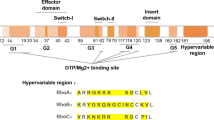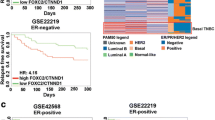Abstract
Epithelial–mesenchymal transition (EMT) is a critical step in tumor progression that leads to the acquisition by cancer cells the capacity for migration using the mesenchymal motility mode regulated by the Rac→WAVE→Arp2/3 signaling pathway. Earlier it was shown that proteins interacting with Rac can regulate mesenchymal migration and thus determine the metastatic potential of the cells. The search for new regulators of cell migration is an important theoretical and practical task. The adaptor protein Anks1a is one of the proteins interacting with Rac, whose expression is altered in many types of tumors. The aim of this study was to find whether Anks1a affects the migration of cancer cells and to identify the mechanism underlying this effect. It was suggested that Anks1a can influence cancer cell migration either as a Rac1 effector or by activating human epidermal growth factor receptor 2 (HER2) exchange. We investigated how upregulation and inhibition of Anks1a expression affected migration of breast cancer cells with different HER2 status. Anks1a was shown to interact with the activated form of Rac1. In the MDA-MB-231 cells (triple negative cancer), which lack HER2, Anks1a accumulated at the active cell edge, which is characterized by enrichment with active Rac1, whereas no such accumulation was observed in the HER2-overexpressing SK-BR-3 cells. Downregulation of the ANKS1a expression with esiRNA had almost no effect on the cancer cell motility, except a slight increase in the average migration rate of MDA-MB-231 cells. Among three cell lines tested, overexpression of Anks1a increased the migration rate of HER2-overexpressng SK-BR-3 cells only. We showed that Anks1a is an effector of activated Rac1, but its influence on the cell migration in this capacity was minimal, at least in the studied breast cancer cells. Anks1a affected the motility of breast cancer cells due to its involvement in the EGF receptor exchange.





Similar content being viewed by others
Abbreviations
- Anks1a:
-
ankyrin repeat and sterile alpha motif domain containing 1A
- EGF:
-
epidermal growth factor
- HER2:
-
human epidermal growth factor receptor 2
- RTK:
-
receptor tyrosine kinase
References
Hanahan, D., and Weinberg, R. A. (2011) Hallmarks of cancer: the next generation, Cell, 144, 646-674, https://doi.org/10.1016/j.cell.2011.02.013.
Svitkina, T. (2018) The actin cytoskeleton and actin-based motility, Cold Spring Harb. Perspect. Biol., 10, a018267, https://doi.org/10.1101/cshperspect.a018267.
Bonello, T. T., Stehn, J. R., and Gunning, P. W. (2009) New approaches to targeting the actin cytoskeleton for chemotherapy, Future Med. Chem., 1, 1311-1331, https://doi.org/10.4155/fmc.09.99.
Raftopoulou, M., and Hall, A. (2004) Cell migration: Rho GTPases lead the way, Dev. Biol., 265, 23-32, https://doi.org/10.1016/j.ydbio.2003.06.003.
Hall, A., and Nobes, C. D. (2000) Rho GTPases: molecular switches that control the organization and dynamics of the actin cytoskeleton, Philos. Trans. R. Soc. Lond. B Biol. Sci., 355, 965-970, https://doi.org/10.1098/rstb.2000.0632.
Krugmann, S., Jordens, I., Gevaert, K., Driessens, M., Vandekerckhove, J., and Hall, A. (2001) Cdc42 induces filopodia by promoting the formation of an IRSp53: Mena complex, Curr. Biol., 11, 1645-1655, https://doi.org/10.1016/s0960-9822(01)00506-1.
Charras, G., and Paluch, E. (2008) Blebs lead the way: how to migrate without lamellipodia, Nat. Rev. Mol. Cell Biol., 9, 730-736, https://doi.org/10.1038/nrm2453.
Wang, W., Wyckoff, J. B., Frohlich, V. C., Oleynikov, Y., Hüttelmaier, S., et al. (2002) Single cell behavior in metastatic primary mammary tumors correlated with gene expression patterns revealed by molecular profiling, Cancer Res., 62, 6278-6288.
Wang, W., Wyckoff, J. B., Goswami, S., Wang, Y., Sidani, M., et al. (2007) Coordinated regulation of pathways for enhanced cell motility and chemotaxis is conserved in rat and mouse mammary tumors, Cancer Res., 67, 3505-3511, https://doi.org/10.1158/0008-5472.CAN-06-3714.
Pankov, R., Endo, Y., Even-Ram, S., Araki, M., Clark, K., Cukierman, E., Matsumoto, K., and Yamada, K. M. (2005) A Rac switch regulates random versus directionally persistent cell migration, J. Cell Biol., 170, 793-802, https://doi.org/10.1083/jcb.200503152.
Zhou, K., Rao, J., Zhou, Z. H., Yao, X. H., Wu, F., Yang, J., Yang, L., Zhang, X., Cui, Y.-H., Bian, X.-W., Shi, Yu, and Ping, Yi-F. (2018) RAC1-GTP promotes epithelial-mesenchymal transition and invasion of colorectal cancer by activation of STAT3, Lab. Invest., 98, 989-998, https://doi.org/10.1038/s41374-018-0071-2.
Kurisu, S., Suetsugu, S., Yamazaki, D., Yamaguchi, H., and Takenawa, T. (2005) Rac-WAVE2 signaling is involved in the invasive and metastatic phenotypes of murine melanoma cells, Oncogene, 24, 1309-1319, https://doi.org/10.1038/sj.onc.1208177.
Rana, P. S., Alkrekshi, A., Wang, W., Markovic, V., and Sossey-Alaoui, K. (2021) The role of WAVE2 signaling in cancer, Biomedicines, 9, 1217, https://doi.org/10.3390/biomedicines9091217.
Taniuchi, K., Yawata, T., Tsuboi, M., Ueba, T., and Saibara, T. (2019) Efficient delivery of small interfering RNAs targeting particular mRNAs into pancreatic cancer cells inhibits invasiveness and metastasis of pancreatic tumors, Oncotarget, 10, 2869-2886, https://doi.org/10.18632/oncotarget.26880.
Takahashi, K., and Suzuki, K. (2011) WAVE2, N-WASP, and Mena facilitate cell invasion via phosphatidylinositol 3-kinase-dependent local accumulation of actin filaments, J. Cell Biochem., 112, 3421-3429, https://doi.org/10.1002/jcb.23276.
Wang, W., Eddy, R., and Condeelis, J. (2007) The cofilin pathway in breast cancer invasion and metastasis, Nat. Rev. Cancer, 7, 429-440, https://doi.org/10.1038/nrc214.
Sinha, P., Hütter, G., Köttgen, E., Dietel, M., Schadendorf, D., and Kage, H. (1999) Increased expression of epidermal fatty acid binding protein, cofilin, and 14-3-3-sigma (stratifin) detected by two-dimensional gel electrophoresis, mass spectrometry and microsequencing of drug-resistant human adenocarcinoma of the pancreas, Electrophoresis, 20, 2952-2960, https://doi.org/10.1002/(SICI)1522-2683(19991001)20:14<2952::AID-ELPS2952>3.0.CO;2-H.
Gunnersen, J. M., Spirkoska, V., Smith, P. E., Danks, R. A., and Tan, S. S. (2000) Growth and migration markers of rat C6 glioma cells identified by serial analysis of gene expression, Glia, 32, 146-154, https://doi.org/10.1002/1098-1136(200011)32:2<146::AID-GLIA40>3.0.CO;2-3.
Davila, M., Frost, A. R., Grizzle, W. E., and Chakrabarti, R. (2003) LIM kinase 1 is essential for the invasive growth of prostate epithelial cells: implications in prostate cancer, J. Biol. Chem., 278, 36868-36875, https://doi.org/10.1074/jbc.M306196200.
Yoshioka, K., Foletta, V., Bernard, O., and Itoh, K. (2003) A role for LIM kinase in cancer invasion, Proc. Natl. Acad. Sci. USA, 100, 7247-7252, https://doi.org/10.1073/pnas.1232344100.
Pandey, A., Blagoev, B., Kratchmarova, I., Fernandez, M., Nielsen, M., Kristiansen, T. Z., Ohara, O., Podtelejnikov, A. V., Roche, S., Lodish, H. F., and Mann, M. (2002) Cloning of a novel phosphotyrosine binding domain containing molecule, Odin, involved in signaling by receptor tyrosine kinases, Oncogene, 21, 8029-8036, https://doi.org/10.1038/sj.onc.1205988.
Shin, J., Gu, C., Park, E., and Park, S. (2007) Identification of phosphotyrosine binding domain-containing proteins as novel downstream targets of the EphA8 signaling function, Mol. Cell Biol., 27, 8113-8126, https://doi.org/10.1128/MCB.00794-07.
Casaletto, J. B., and McClatchey, A. I. (2012) Spatial regulation of receptor tyrosine kinases in development and cancer, Nat. Rev. Cancer, 12, 387-400, https://doi.org/10.1038/nrc3277.
Lemmon, M. A., and Schlessinger, J. (2010) Cell signaling by receptor tyrosine kinases, Cell, 141, 1117-1134, https://doi.org/10.1016/j.cell.2010.06.011.
Park, S., Lee, H., Lee, J., Park, E., and Park, S. (2019) Ependymal cells require Anks1a for their proper development, Mol. Cells, 42, 245-251, https://doi.org/10.14348/molcells.2018.0432.
Lee, Y., Yoon, K. A., Joo, J., Lee, D., Bae, K., Han, Ji-Y., and Lee, J.-S. (2013) Prognostic implications of genetic variants in advanced non-small cell lung cancer: a genome-wide association study, Carcinogenesis, 34, 307-313, https://doi.org/10.1093/carcin/bgs356.
Lee, H., Noh, H., Mun, J., Gu, C., Sever, S., and Park, S. (2016) Anks1a regulates COPII-mediated anterograde transport of receptor tyrosine kinases critical for tumorigenesis, Nat. Commun., 7, 12799, https://doi.org/10.1038/ncomms12799.
Tong, J., Sydorskyy, Y., St-Germain, J. R., Taylor, P., Tsao, M. S., and Moran, M. F. (2013) Odin (ANKS1A) modulates EGF receptor recycling and stability, PLoS One, 8, e64817, https://doi.org/10.1371/journal.pone.006481.
Kristiansen, T. Z., Nielsen, M. M., Blagoev, B., Pandey, A., and Mann, M. (2004) Mouse embryonic fibroblasts derived from Odin deficient mice display a hyperproliiferative phenotype, DNA Res., 11, 285-292.
Sladitschek, H. L., and Neveu, P. A. (2015) MXS-chaining: a highly efficient cloning platform for imaging and flow cytometry approaches in mammalian systems, PLoS One, 10, e0124958, https://doi.org/10.1371/journal.pone.0124958.
Molinie, N., Rubtsova, S. N., Fokin, A., Visweshwaran, S. P., Rocques, N., Polesskaya, A., Schnitzler, A., Vacher, S., Denisov, E. V., Tashireva, L. A., Perelmuter, V. M., Cherdyntseva, N. V., Bièche, I., and Gautreau, A. M. (2019) Cortical branched actin determines cell cycle progression, Cell Res., 29, 432-445, https://doi.org/10.1038/s41422-019-0160-9.
Gorelik, R., and Gautreau, A. (2014) Quantitative and unbiased analysis of directional persistence in cell migration, Nat. Protoc., 9, 1931-1943, https://doi.org/10.1038/nprot.2014.131.
Holliday, D. L., and Speirs, V. (2011) Choosing the right cell line for breast cancer research, Breast Cancer Res., 13, 215, https://doi.org/10.1186/bcr2889.
Kraynov, V. S., Chamberlain, C., Bokoch, G. M., Schwartz, M. A., Slabaugh, S., and Hahn, K. N. (2000) Localized Rac activation dynamics visualized in living cells, Science, 290, 333-337, https://doi.org/10.1126/science.290.5490.333.
Mehidi, A., Rossier, O., Schaks, M., Chazeau, A., Binamé, F., Remorino, A., Coppey, M., Karatas, Z., Sibarita, J.-P., Rottner, K., Moreau, V., and Giannone, G. (2019) Transient activations of Rac1 at the lamellipodium tip trigger membrane protrusion, Curr. Biol., 29, 2852-2866.e5, https://doi.org/10.1016/j.cub.2019.07.035.
Itoh, R. E., Kurokawa, K., Ohba, Y., Yoshizaki, H., Mochizuki, N., and Matsuda, M. (2002) Activation of rac and cdc42 video imaged by fluorescent resonance energy transfer-based single-molecule probes in the membrane of living cells, Mol. Cell Biol., 22, 6582-6591, https://doi.org/10.1128/MCB.22.18.6582-6591.2002.
Steffen, A., Ladwein, M., Dimchev, G. A., Hein, A., Schwenkmezger, L., Arens, S., Ladwein, K. I., Holleboom, J. M., Schur, F., Small, J. V., Schwarz, J., Gerhard, R., Faix, J., Stradal, T. E. B., Brakebusch, C., and Rottner, K. (2013) Rac function is crucial for cell migration but is not required for spreading and focal adhesion formation, J. Cell Sci., 126, 4572-4588, https://doi.org/10.1242/jcs.118232.
Weiss-Haljiti, C., Pasquali, C., Ji, H., Gillieron, C., Chabert, C., Curchod, M. L., Hirsch, E., Ridley, A. J., van Huijsduijnen, R. H., Camps, M., and Rommel, C. (2004) Involvement of phosphoinositide 3-kinase gamma, Rac, and PAK signaling in chemokine-induced macrophage migration, J. Biol. Chem., 279, 43273-43284, https://doi.org/10.1074/jbc.M402924200.
Funding
This study was conducted within the framework of the International Associated Laboratory (LIA) research project “Novel machineries controlling cell migration and their role in cancer progression” (MIG MAC) and supported by the Russian Foundation for Basic Research (project no. 18-54-16006 to A. Y. A).
Author information
Authors and Affiliations
Contributions
A. Y. Alexandrova and A. M. Gautreau developed the concept and supervised the study; A. O. Zholudeva, M. E. Lomakina, E. A. Orlova, Y. Wang, A. Fokin, and A. Polesskaya performed the experiments; A. Y. Alexandrova, A. M. Gautreau, A. O. Zholudeva, M. E. Lomakina, A. Fokin, A. Polesskaya discussed the results; A. Y. Alexandrova, A. O. Zholudeva, M. E. Lomakina, A. Fokin wrote and edited the text.
Corresponding author
Ethics declarations
The authors declare no conflict of interest. This article does not contain description of studies with human participants or animals performed by any of the authors.
Rights and permissions
About this article
Cite this article
Zholudeva, A.O., Lomakina, M.E., Orlova, E.A. et al. The Role of the Adapter Protein Anks1a in the Regulation of Breast Cancer Cell Motility. Biochemistry Moscow 87, 1651–1661 (2022). https://doi.org/10.1134/S0006297922120203
Received:
Revised:
Accepted:
Published:
Issue Date:
DOI: https://doi.org/10.1134/S0006297922120203




